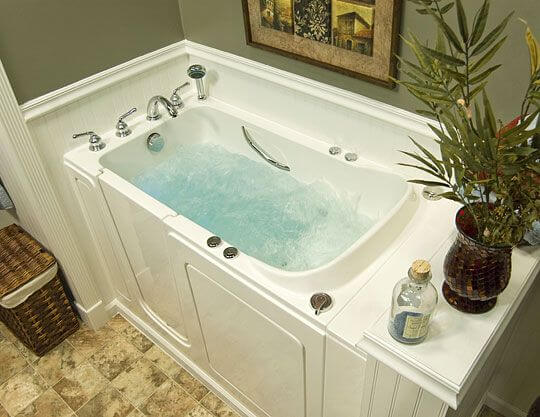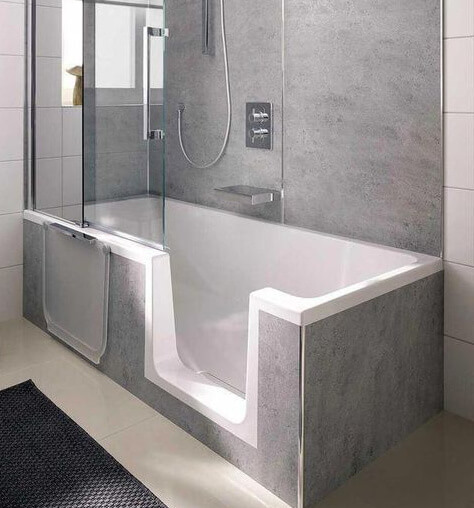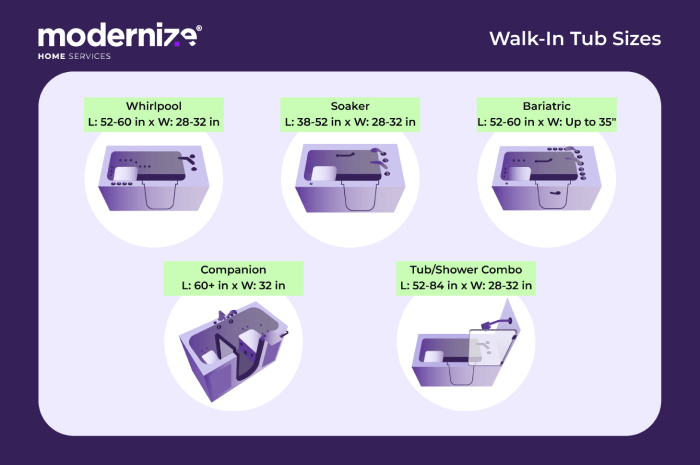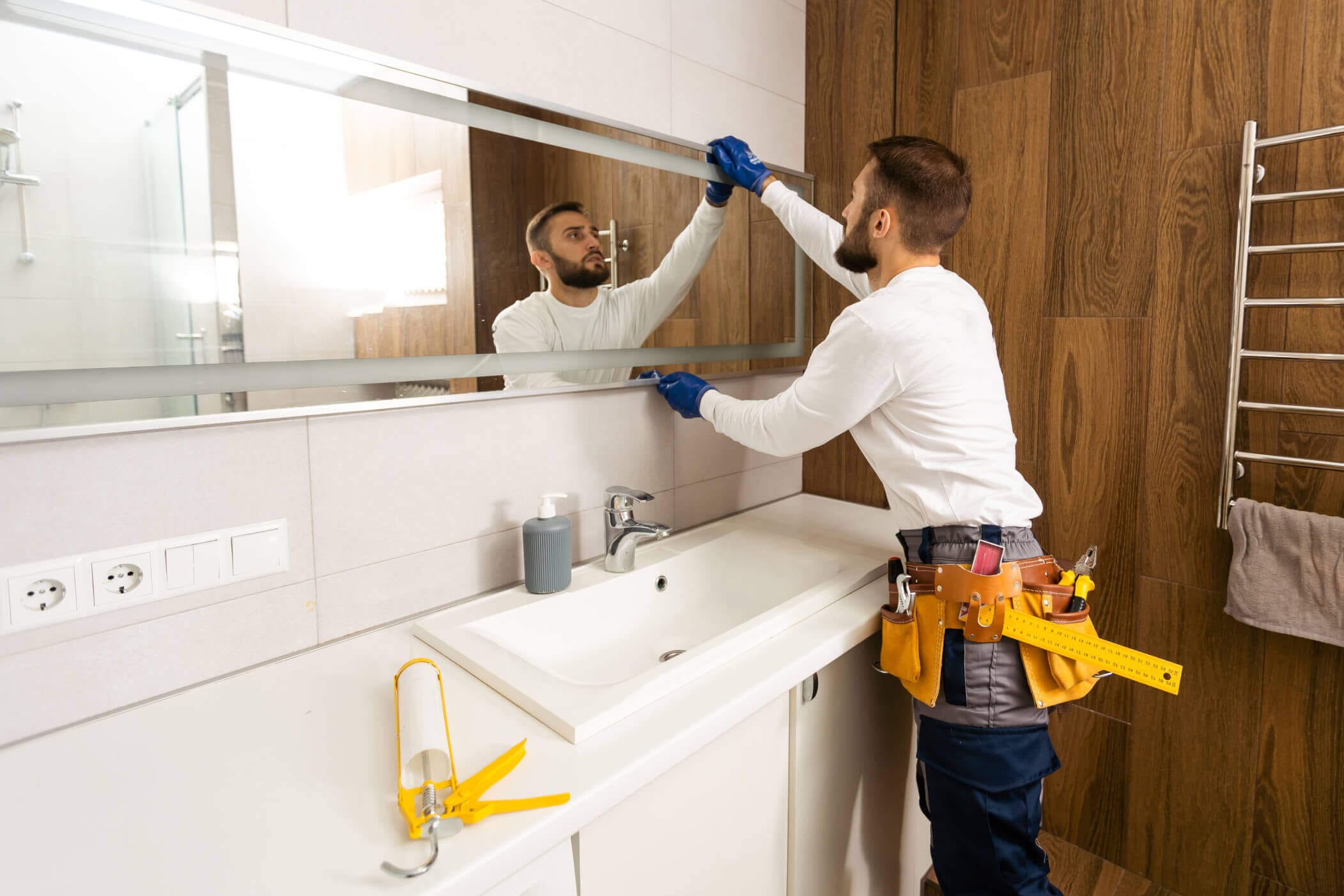Walk-In Tub Installation
Walk-in tubs are essential fixtures for homeowners who prioritize safety, accessibility, and comfort, especially for seniors who want to age in place and individuals looking to make home accessibility modifications in 2026. These tubs are designed with a leak-proof door and a low threshold, making it easy and safe to step inside.

What Is a Walk-In Tub System?
A walk-in tub system is a specialized bathing solution designed to improve safety and convenience for homeowners with limited mobility. These tubs feature a watertight door with a low threshold, allowing users to walk into the tub without stepping over a high edge. These tubs also allow you to bathe while sitting. Key components include grab bars, a raised seat, slip-resistant flooring, and anti-scald technology. Optional features such as hydrotherapy jets, quick-drain technology, and aromatherapy enhance the bathing experience.
Frequently Asked Questions
How Does a Walk-In Tub System Work?
Tubs are equipped with features that prioritize safety and ease of use. Once the user steps into the tub and closes the door, a watertight seal is formed. The tub fills with water while the individual sits comfortably on the built-in seat. After bathing, quick-drain technology ensures minimal wait time before exiting.
Frequently Asked Questions
What Are the Different Types of Walk-In Tub Systems?
Walk-in tubs come in a variety of designs, each tailored to meet specific needs and preferences. Choosing the right type of walk-in tub depends on factors such as your medical requirements, preferred features, and whether you need a tub that can accommodate multiple family members. Here are some of the most common types:
- Soaking Tubs: These are the simplest and most affordable option. They are designed for relaxation and basic bathing needs without any additional therapeutic features.
- Hydrotherapy Tubs: Equipped with water jets, these tubs provide a spa-like experience, ideal for individuals with chronic muscle pain, arthritis, or other conditions that benefit from therapeutic water massage.
- Wheelchair-Accessible Tubs: Designed for individuals who use wheelchairs, these tubs have wide doors, low thresholds, and spacious interiors to allow for easy transfer.
- Bariatric Tubs: Larger in size, these tubs are built to accommodate individuals with higher weight capacities, offering extra space and reinforced construction.
- Combination Tubs: These tubs combine multiple features, such as hydrotherapy and air jets, for a customized bathing experience. They may also include aromatherapy or chromotherapy options.
Exploring the various types of walk-in tubs can help you find the best fit for your home and specific needs. Consulting with a professional can also provide insights into the features and benefits of different models.

Choosing the Right Walk-In Tub System for Your Home
Walk-in tubs are a unique and practical solution for enhancing bathroom safety and comfort, especially for individuals with mobility challenges. Unlike traditional bathtubs, walk-in tubs are equipped with a range of features designed to minimize the risk of slips, falls, and other injuries, making them an excellent choice for aging in place or improving accessibility in your home.
One of the standout features of a walk-in tub is its door, which opens to provide a low threshold for easy entry. This eliminates the need to step over high tub walls, allowing users to simply “walk into” the tub. Once the door is securely closed, it creates a watertight seal that prevents leaks, letting you fill the tub without worrying about spills or messes.
Essential Safety Features
When selecting a walk-in tub system, safety is paramount. Most models come with standard features designed to ensure a safe and comfortable bathing experience. These include:
- Sturdy grab bars to provide stability during entry and exit.
- Inward or outward swinging doors for secure closure and easy access.
- Low thresholds to reduce tripping hazards.
- Raised seating for added comfort and support while bathing.
- Slip-resistant flooring to prevent accidental falls.
- Anti-scald protection to maintain safe water temperatures and avoid burns.
Additional Comfort Features
For an upgraded bathing experience, many walk-in tubs offer optional features that enhance relaxation and convenience:
- Quick-fill and quick-drain technology to reduce waiting times.
- Detachable showerheads or spray spouts for added flexibility.
- Hydrotherapy massage jets to alleviate muscle tension and promote relaxation.
- Aromatherapy and chromotherapy options for a spa-like experience.
- Self-cleaning systems to simplify maintenance and ensure hygiene.
Alternative Option: Roll-In Showers
If a bath isn’t your preference, consider a roll-in shower as an alternative. Designed for wheelchair accessibility, roll-in showers feature low thresholds, slip-resistant surfaces, and ADA-compliant seating, offering the same safety and convenience in a showering format.
When choosing the right walk-in tub system for your home, assess your specific needs, preferences, and space constraints. Consulting with a professional installer can help ensure you select a model that aligns with your safety and comfort goals while fitting seamlessly into your bathroom layout.
Frequently Asked Questions
Walk-in Tubs: Common Components, Features, and Sizes
Understanding the components of a walk-in tub can help you make informed decisions:
- Leak-Proof Door: Doors typically seal to keep the water from leaking out onto your bathroom floor.
- Low Threshold: Walk-in tubs with a low threshold make it easy to get in and out of the bath.
- Grab Bars: These bars allow ease of movement for individuals with reduced mobility.
- Slip-Resistant Flooring: Floors are designed to keep users from slipping and falling while taking a bath.
- Quick-Drain System: Users must wait inside the tub while it drains, but quick draining reduces the time you’ll sit, waiting for the water to fully drain.
- Optional Features: Other options for your walk-in tub include hydrotherapy jets, aromatherapy devices, and self-cleaning systems.
Dimensions of a Walk-In Tub
Choosing the right size walk-in tub is important for your health and needs, as well as ensuring the tub will fit in your bathroom.

Walk-In Tub Length and Width
Most walk-in tubs are designed to fit in the alcove space of a standard bathtub.
A standard bathtub’s dimensions are 30 inches wide by 60 inches long, and most walk-in tubs measure 30 inches wide by 60 inches long, but the standard width can be up to 32 inches. To put these dimensions into perspective, most “companion tubs,” which are designed to fit two users at the same time, are 60 inches in length.
Some brands carry smaller walk-in tubs for petite individuals that feature a shorter length – as small as 40 inches in length. Keep in mind that if you plan to recline in the tub, you will need a length closer to 60 inches.
Walk-In Tub Height
Walk-in tubs are usually taller than standard bathtubs. Because most users sit inside of these tubs, the water depth needs to be about 3 to 4 feet in height to reach the user. Walk-in tubs have a height of 20 to 45 inches tall, though some types do not require as much height.
Water Capacity and Hot Water Requirements
Keep in mind that due to the height, walk-in tubs usually require more water capacity than standard bathtubs. It is important to make sure your home’s water heater can support the water needed during a bath.
The smallest walk-in tubs need 38 to 40 gallons of water per bath, and the largest can require 100 or more gallons of hot water. To put this into perspective, according to Energy.gov, a typical shower requires 20 gallons of hot water.
Modernize recommends talking to your contractor about the size of your hot water heater, and checking to see if your home may need to upgrade its size to support your new walk-in tub.
Frequently Asked Questions
Topics to Explore
How to Maintain Your Walk-In Tub System
Routine maintenance ensures the longevity and performance of your walk-in tub. Clean the tub regularly, check seals for leaks, and service optional components like hydrotherapy jets. Avoid using harsh chemicals and bath oils that could damage the surface or seals.
Frequently Asked Questions
Walk-In Tub Costs and Installation Tips
The cost of a walk-in tub varies widely depending on the type of tub, features included, and the complexity of installation. Homeowners should plan for both the purchase price and any additional installation expenses when budgeting for a walk-in tub.
Average Costs by Type
- Basic Soaking Tubs: These are the most affordable walk-in tub option, with prices ranging from $2,000 to $5,000, including installation.
- Tubs With Special Features: Models that include features like hydrotherapy jets, air jets, or wheelchair accessibility typically cost between $5,000 and $10,000.
- Premium and Custom Tubs: High-end models with advanced features or custom designs can exceed $10,000, depending on the options selected.
Installation Considerations
- Extent of Work: Installation costs may increase if modifications to your bathroom are required, such as widening doorways, reinforcing flooring, or adjusting plumbing systems.
- Electrical Upgrades: Some walk-in tubs with advanced features like jets or heated seating may require additional electrical work to accommodate the power needs.
- Professional Installation: Always hire a licensed contractor to ensure the tub is installed safely and properly, preserving warranties and meeting building codes.
Cost-Saving Tips
- Compare Brands and Models: Research top-rated walk-in tub brands to find a high-quality option that fits your budget.
- Explore Financing Options: Some manufacturers and retailers offer financing plans to make purchasing a walk-in tub more manageable.
- Check for Rebates or Assistance Programs: Some health insurance plans, Medicare Advantage, or local programs may offer partial reimbursements if the tub is deemed medically necessary.
By understanding the costs and installation requirements, you can plan for a walk-in tub investment that enhances safety and comfort in your home.
See the table below for popular types and their costs.
| Type | Best for | Cost Range | Features |
|---|---|---|---|
| Soaking Tubs | Basic safety and relaxation | $2,000 to $5,000 | Standard features like grab bars and seats |
| Hydrotherapy Tubs | Pain relief and muscle relaxation | $5,000 to $10,000 | Massage jets and heated surfaces |
| Wheelchair-Accessible Tubs | Wheelchair users | $5,000 to $10,000+ | Outward-swinging doors, extra clearance |
| Bariatric Tubs | Larger individuals | $5,000 to $10,000+ | Wider dimensions and reinforced structure |
Frequently Asked Questions
Topics to Explore
How to Choose a Contractor for Walk-In Tub Installation
Installing a walk-in tub is a significant investment in safety and comfort, and selecting the right contractor is crucial to ensure a seamless process. Here are some essential tips for finding a qualified professional:
- Get Multiple Quotes: Reach out to several contractors to compare costs, services, and timelines. Obtaining multiple quotes allows you to make an informed decision based on your budget and project needs.
- Review Detailed Quotes: Ensure that each quote includes a breakdown of costs for the tub, labor, permits, and any additional fees. This transparency helps you understand the total expenses and avoids unexpected charges later.
- Evaluate Experience: Ask contractors about their experience installing walk-in tubs. Request references from past clients to verify their expertise and quality of work. A contractor with a solid track record in accessibility modifications is a plus.
- Check Licensing and Insurance: Confirm that the contractor is licensed in your state and carries general liability and workers’ compensation insurance. This protects you from liability in case of accidents or damage during installation.
- Avoid Large Upfront Payments: Reputable contractors typically require a small deposit, not a large upfront payment. Be cautious of any contractor demanding a significant payment before work begins, as this could be a red flag.
- Ask About Warranties: Inquire whether the contractor offers warranties on both labor and materials. Reliable contractors will provide warranties to guarantee their work and protect your investment.
Frequently Asked Questions
Common Problems with Walk-In Tub Systems and How to Fix Them
Walk-in tubs are designed for durability and ease of use, but like any home system, they may encounter occasional issues. Here are some common problems, their potential causes, and how to address them effectively:
- Leaks: Over time, the door seal of a walk-in tub may wear out, leading to leaks. Regularly inspecting the seal for damage and cleaning it to remove debris can help maintain its effectiveness. If leaks persist, replacing the seal is often a straightforward fix that can be handled by a professional.
- Slow Drainage: A slow-draining tub can occur due to clogs in the drain or plumbing system. Homeowners can attempt to clear minor clogs using a plunger or a safe drain cleaner. However, for persistent issues, it’s best to consult a plumber to avoid further damage.
- Malfunctioning Jets: Hydrotherapy or air jets may malfunction due to mineral buildup or mechanical issues. Cleaning the jets with a manufacturer-recommended solution can resolve buildup-related problems. If the jets still don’t work, professional servicing may be necessary to repair or replace components.
- Electrical Malfunctions: If the tub’s powered features, like jets or heated seats, fail, the issue might stem from a tripped circuit breaker or loose wiring. Always check your electrical panel first. For more complex electrical problems, contact a licensed technician.
- Door Difficulties: If the tub’s door becomes difficult to open or close, inspect the hinges and locking mechanism for debris or misalignment. Lubricating the hinges or adjusting the mechanism can often resolve the problem. Persistent issues may require professional assistance.
Tips for Preventing Walk-In Tub Issues
- Regularly clean and inspect your tub, especially the door seal, jets, and drain.
- Use manufacturer-recommended cleaning agents to avoid damaging components.
- Schedule annual maintenance checks with a professional to ensure the system operates efficiently.
Frequently Asked Questions
Costs, Rebates, and Environmental Impact of Walk-In Tub Systems
Walk-in tubs not only improve accessibility but can also contribute to energy and water efficiency, making them a smart investment for eco-conscious homeowners. Many manufacturers offer energy-efficient models designed to minimize water usage while maintaining comfort and performance. These tubs are often equipped with features such as low-flow faucets, quick-fill spouts, and fast-drain technology, which reduce overall water consumption without compromising functionality.
In addition to the environmental benefits, financial incentives may be available to offset the cost of installing an energy-efficient walk-in tub. Programs at the federal, state, and local levels, as well as rebates from utility companies, can help reduce upfront expenses. Manufacturers may also offer promotions or discounts on models that meet specific efficiency standards. Consult with your contractor or manufacturer to explore available options.
Opting for an energy-efficient walk-in tub not only saves money over time through reduced utility bills but also helps conserve precious resources, making it a win-win for both your household and the environment.
Frequently Asked Questions
What to Do After Installing/Replacing a Walk-In Tub System
Post-installation care is crucial for maintaining performance. Regularly inspect seals, clean components, and monitor optional features like hydrotherapy jets.
Checklist:
- Clean the tub after each use.
- Inspect the door seal monthly.
- Schedule annual maintenance.
Investing in a walk-in tub is a commitment to safety, comfort, and independence. With the right system, proper maintenance, and expert installation, you can enjoy the benefits for years to come.
Ready to get your project started?
Let us find the best Walk In Tubs pros in your area, then easily request quotes, book a contractor, and get the job done. It's that easy.

Homeowner Resources
Here are the top articles that homeowners found useful when planning their Walk In Tubs project and navigating the contractor hiring process.

Real Stories, Real Success
See how our solutions empower homeowner projects and experiences.